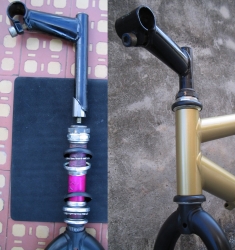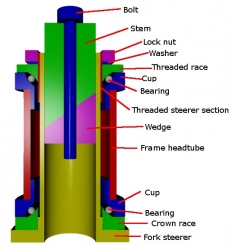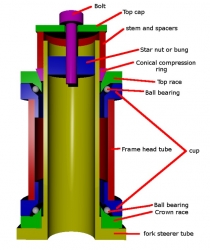Bike headset

The headset is a rotatable interface that mounts the bike forks into the frame. It consists of two cups (upper and lower head-tube races) that are pressed into the top and bottom of the head tube of the bike frame. They allow the forks the necessary movement for steering by using smooth bearings simultaneously held in place by the cups of the headset.
While all headset cups are pressed into the frame, there are two ways in which they hold onto the steerer tube of the forks:
Threaded - The steerer tube of the forks has threads on the end, so that when it slides up through the headset, a lock nut at the top of the headset threads directly onto the steerer tube, tightly keeping it and the guts of the headset held in the frame.

Threadless - A star nut is inserted inside the fork steerer tube. When the headset is assembled with all the spacers, bearings, and stem, a bolt in the top cap reaches down and threads into the star nut. Tines on the star nut dig into the walls of the fork steerer tube, holding the forks and the headset pressed together.

Headsets (and their assorted pieces) can be bought online in any size and compatibility, however 1 1/8" threadless headsets are the most common. Chris King, Cane Creek, and FSA are a few brands that dominate the aftermarket headset scene.
Threadless headsets can range from less than $20 to over $400 on Amazon.com with a median price a little less than $50.
Threaded headsets are simpler and take less time to manufacture, therefore they are cheaper. Some Threaded headsets come for less than $10 online with the Amazon price range topping out at $145, with a median around $25.
Headsets are very hardy components that rarely need replaced. However if symptoms of a loose or broken headset persist, don't fret. It's not as hard as you might think.
Signs of a worn headset:
- Shaking - the headset is too loose, and is rattling in the frame,
- Stiffness - the headset is too tight, and steering comes with resistance.
- Indexed steering - the bearings in the headset create dimples which makes the headset favor steering at a certain angle.
None of the above are fun, and if you can't adjust the headset to make it work, an overhaul may be in order. To remove the headset:
Threaded - Unscrew the locknut, and remove any spacers, and finally the threaded bearing race. The forks will fall from the frame.

- Threadless - When the top cap is removed and the stem is off, the spacers should come out easily. Usually the steerer tube will be still sitting comfortably in the bearing race cup, but a simple, light hit with a hammer (through a block of wood to avoid damage) should dislodge the forks.

With the forks removed, check the health of the bearings in the headset. Threadless headsets have cartridge bearings that can be easily replaced. If they are loose or not rotating smoothly in threaded systems, the entire headset may need to be replaced. When replacing any bearings always use an excess of grease.
Because the cups are press fit, the head-tube races come out simply with a screwdriver or a hammer, alternating sides with light impacts will take them out. It's a good idea to have the bike frame on a rotatable repair stand, so each head-tube race can be hammered on from different angles.
To install the new headset, the races need to be pressed in using a mallet, or a block of wood/hammer setup. When the new cups and bearings are installed, replace the steerer tube, the spacers, and finally lock down the stem.
NOTE: Sometimes the head-tube races won't be 100% tight the first try. If you notice the signs of a loose headset, rest assured you're banging the cups into place as you ride. Take it on home and tighten it down once and for all.
The outside diameter of the steerer tube dictates the size of the headset. When measuring the headset, it is important to double-check the dimensions that are actually being measured. It's common to mistake the diameter of the stem or steerer tube for that of the headset.
Most threaded headsets are standardized at 1 inch, with a minority having diameters of 1 1/8 inch.
Threadless headsets have an ISO (International Standardization Organization) 1 inch diameter, but most new mountain bikes use 1 1/8 inch. Tandem bicycles in both classes use 1 1/4 inch headsets.
| Common Threaded Headset Sizes | |||||
| Type of headset/Steerer outside diameter | Crown Race inside diameter | Frame cup outside diameter | Threads per inch | Notes | |
| French/ 25mm | 26.5mm, 27mm | 30.2mm | 25.4tpi | Obsolete. Bottom headset components wear fast, but the upper parts can be used in compatibility with ISO standard 1" headsets. | |
| 1" ISO standard (25.4mm) | 26.4mm | 30.2mm | 24tpi | Standard 1" headset size. | |
| 1" Italian (25.4mm) | 26.5mm, 27mm | 30.2mm | 24tpi | Obsolete. Threads have an awkward pitch of 55 degrees, but ISO components can be interchanged if the other minimal sizing differences are overlooked. | |
| 1" Raleigh (25.4) | 26.4mm | 30.2mm | 26tpi | Size used exclusively on Raleigh bikes from the UK | |
| Austrian (26mm) | 26.7mm | 30.8mm | 25.4tpi | High quality Austrian-made bikes use these dimensions. Compatible with ISO. | |
| Tandem 1 1/4" (31.8mm) | 33.0mm | 37.0mm | 26tpi | Commonplace on tandem bikes worldwide. | |
| Common Threadless Headset Sizes | |||
| Headset size | Crown Race inside diameter | Frame Cup outside diameter | Notes |
| 1" ISO standard (25.4mm) | 26.4mm | 30.2mm | Standard 1" size throughout the threadless market |
| 1 1/8" (28.6mm) | 30.0mm | 34.0mm | Used on many new mountain bikes |
| 1 1/4" (31.8mm) | 33.0mm | 37.0mm | Used on tandem bikes |
| 1.5" (38.1mm) | 39.8mm | 49.6mm | Proposed new standard on downhill machines. |